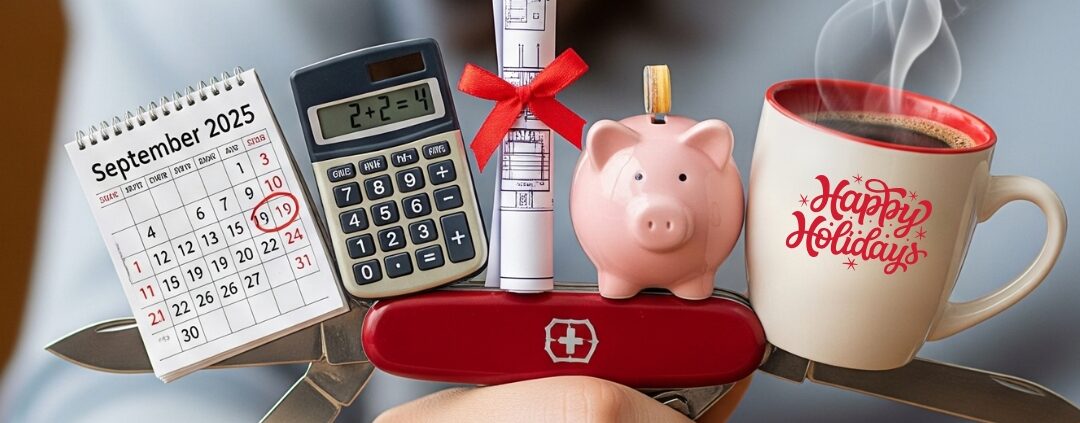
By: Aly J. Yale & Tanza LoudenbackAs seen in Buy Side from Wall Street Journal (WSJ)
- Updated September 11, 2024, 10:42 AM EDT
How to Pay for a Home Renovation
Home renovations can be exciting, but paying for them requires a lot of planning. If you aren’t careful you could end up with unnecessary debt.
The best way to pay for a home improvement, be it a kitchen refresh or emergency roof repair, is to use cash savings—it costs nothing in interest and leaves you owing no one. But many people don’t have that kind of financial wiggle room. According to data from the Federal Reserve, more than a third of those surveyed couldn’t cover a $400 emergency expense with cash or its equivalent. And home renovations can reach tens of thousands of dollars or more, depending on the project.
If you need to borrow money, your first thought might be a credit card, since these offer a fast, easy route to extra cash. But unless you can pay off the balance in full within a few months, there are smarter, and less costly, ways to borrow money for home renovations—for example: a home equity loan, a home equity line of credit, a rehab loan backed by the federal government or a personal loan.
With the help of personal finance and mortgage experts, we’ll walk you through the best options for financing a home renovation.
Methodology
Our team gathered over 700 data points on two dozen lenders to identify the best personal loans for home improvement. We considered a wide range of criteria, including rates and terms, loan fees, maximum loan amounts, eligibility, customer satisfaction and lender access, funding times and discounts. For further insight, please read our full methodology.
What are home improvement loans and how do they work?
A home improvement loan is a loan taken out to fund renovations and/or maintenance for your home. Many are installment loans, meaning you receive money upfront and repay it, with interest, in monthly installments. But some borrowing options, such as home equity lines of credit, function more like a credit card, and are a form of revolving debt.
What to know about paying for home improvements
Home improvement projects come in all shapes and sizes, from water heater repairs to knocking out walls and expanding your home’s footprint. They’re generally one of two kinds: nice-to-have or need-to-have.
Figure out which category your project falls into before you decide how to pay for it, says Taylor Kovar, founder of Kovar Wealth Management in Lufkin, Texas, because not all projects justify taking on debt.
Need-to-have
Emergencies happen—pipes burst, roofs rot and appliances need replacing. If you have to make a repair to maintain the condition or comfort of your home and you’re short on cash, debt might be your only lifeline. As it happens, the quickest way to get cash will likely cost the most in the long run.
Which is why, ideally, you should aim to budget for need-to-have projects ahead of time, says Jenna Biancavilla, a Phoenix financial planner.”You should be planning for maintenance and repair, especially if you didn’t buy a new build,” Biancavilla says. As a rule of thumb, you can expect those costs to equal about 1% to 4% of your home’s value each year, she says.
For example: For a $500,000 home that means having anywhere from about $5,000 to $20,000 ready to go in a savings or checking account. (Generally speaking, the bigger the house, the more you should budget.)
Nice-to-have
The motivation behind these projects is often cosmetic or luxury. They usually aren’t urgent and therefore may be something to save up for instead of financing.
There are exceptions, though, like if you’re making improvements to increase the value of your home to sell it soon. In these cases, taking on debt may be justified. Just bear in mind the data: While improving curb appeal and upgrading highly-trafficked areas such as kitchens and bathrooms will often boost a home’s value, it’s unlikely you’ll recoup 100% of the money you put into a remodel.
With a purpose and a timeline for your project in mind, here are several payment options to consider.
Savings
Best if: You have a robust savings account
Pros:
- Allows you to avoid taking on debt
- May be eligible for cash payment discounts
- Doesn’t impact your credit score
- Doesn’t increase your debt-to-income ratio (DTI)
Cons:
- Takes money away from your savings
If you have the savings to cover your renovations—even partially, then that’s the route to explore first. Not only will it reduce or even eliminate interest costs, but it could even qualify you for discounts. (Some contractors and suppliers will give you discounts for cash payments, as credit cards come with processing fees.)
Just make sure you don’t drain your savings completely to pay for the upgrades. Financial pros generally recommend that you have at least three to six months of expenses saved up in case of an emergency. If you have a job with unpredictable hours or income, you might want a little more in the bank to be safe.
Home equity loan
Best if: You have sufficient equity in your home and are comfortable using it as collateral
Pros:
- Fixed monthly payments
- Lower average interest rates than credit cards
- Repayment periods from five to 30 years
- Interest payments may be tax deductible
Cons:
- Approval to funding can take up to two months
- Fixed loan amount
- May have prepayment penalties
- Your home is collateral, so missing payments can lead to foreclosure
- Usually comes with closing costs
If you have substantial home equity, a home equity loan can be a great, low-cost way to borrow money. You’ll encounter less red tape than you would with a Federal Housing Administration-backed loan, and you may be able to borrow more.
Your home equity is the difference between the home’s appraised value and what you owe on your mortgage. Home equity loans, also called second mortgages, let you borrow a fixed amount of money from that equity pot and use it however you want. (Lenders typically require homeowners to keep at least 15% to 20% equity, so you can’t borrow against all of it.)
For example: If your home is worth $500,000,, and your mortgage balance is $200,000, then your equity is $300,000. The lender will evaluate your credit profile, decide how much you can borrow and give you a lump sum if approved.
Repaying a home equity loan is straightforward: Monthly payments are made up of principal and interest—which may be tax-deductible if the money is used to “buy, build or substantially improve your home”—and they begin almost immediately after you receive the cash.
The fact that the loan is for a fixed amount makes it a smart tool for staying on budget, says Kovar, unlike using credit cards or a home equity line of credit (more on that later).
Home equity loan interest rates are fixed and tend to be slightly higher than primary mortgage rates, yet still far below credit card rates and personal loans rates, particularly for borrowers with good to excellent credit.
“If you have the equity in your house, you’re gonna get the best interest rates, because your house is being put up as collateral,” Biancavilla says. But that’s also a risk. If you fail to repay what you owe on the loan, your lender can foreclose on the property and take your home. (The same rules apply to your primary mortgage.)
Warning: If your house loses value, you could end up owing more on your home than it’s worth—sometimes called going “upside-down” on your mortgage. This would mean you could sell your home and not make enough to repay what you owe.
Home equity line of credit
Best if: You want a form of revolving credit and are willing to use your house as collateral
Pros:
- Ability to borrow what you need, when you need it
- Initial payments are interest-only
- Potential for a lower interest rate in the future
- Interest payments may be tax-deductible
Cons:
- Approval to funding can take up to six weeks
- Floating interest rates mean payments can go up
- Lower initial payments can lead to overborrowing
- House is collateral
- May come with closing costs
A home equity line of credit, or HELOC, is a way to set up a revolving line of credit, which lets you pull money from the equity in your home whenever you need it, up to a certain limit. It’s like a credit card, except it’s backed by the value of your home.
HELOCs can be a good method for financing home improvement projects with unpredictable costs, saving you from borrowing too much, or more likely, too little. “Everyone underestimates what they’re going to need,” says Biancavilla. They may also be appealing if interest rates are expected to drop soon, since you don’t lock in a fixed rate with a HELOC (more on that in a moment).
Most HELOCs give you access to a line of credit for 10 years, known as the draw period. During that time you only have to make interest payments on what you actually borrow (and, like home equity loans, you may be able to deduct those payments on your taxes as long as you use the funds to substantially improve your home).
Keep in mind: This means you’re paying a lot less in the beginning than you would with a home equity loan to borrow the same amount of money—but that can sometimes be a “trap,” says Kovar. Eventually, both interest and principal payments will come due.
“If you can’t afford to pay that loan back while you’re doing it, then what are you leaning on to be able to pay it back after the fact?” he says.
As Biancavilla puts it, “If someone can only pay the interest, [they’re] gonna end up home broke and that’s not a good long-term financial strategy.” Ideally, the homeowner will make an effort to repay what they borrow in full along the way to keep interest costs down and replenish the line of credit, she says.
That’s one other perk of paying the principal during your draw period: If you repay some or all of what you owe, you bring your credit limit back up, and can borrow more as you need it. This has the added benefit of reducing your credit utilization ratio, which can improve your credit score.
One more thing: Like credit cards, HELOCs have variable interest rates, where your rate changes based on prevailing market rates, sometimes as often as every month. When your rate moves up or down, so does your payment.
FHA-backed loan
Best if: You have little home equity and/or a low credit score
Pros:
- Little home equity needed
- Fixed- and adjustable-rate loans available
- Minimum credit score requirement as low as 500 (depends on individual lender)
- Loan terms range from six months to 30 years, depending on type
Cons:
- Less spending flexibility
- Maximum borrowing amount may be lower than loans not backed by the government
You might think of the Federal Housing Administration as mainly helping first-time home buyers get mortgages. But the government agency also backs home improvement loans for certain types of projects.
With a Title I loan, you can get up to $25,000 to spend on projects that make your home “more livable and useful.” That includes things like adding built-in appliances, widening doorways or remodeling your kitchen to better accommodate someone who is disabled, and installing solar panels. If you hire a contractor, you may be able to use the loan to cover labor and materials, but if you do the work yourself, you can only cover the cost of materials.
Keep in mind: Pools, outdoor fireplaces and other luxury projects are not eligible for financing with a Title I loan, so if you want full spending flexibility, this loan may not be for you.
You don’t need to have an FHA mortgage to qualify for a Title I loan, but you need to apply for the loan through an FHA-approved lender and meet its individual lending requirements. You can expect interest rates to be similar to typical rates on FHA mortgages, but the rate you get is determined by the lender.
Good to know: Due to FHA guidelines, Title I loans between $7,500 and $25,000 are secured by your home. Loans for less than $7,500 don’t require collateral.
Another government-backed option, the FHA 203(k) rehab loan, is for new buyers or homeowners who are refinancing. It lets you combine a home improvement loan of at least $5,000 with a new mortgage or refinanced mortgage. For example, say the purchase price for a home is $300,000 and your down payment is $30,000, your mortgage would ordinarily be $270,000.
With a rehab loan, you can take out more than you need for the mortgage, say $290,000, and use the remaining funds for home repairs. It’s similar to a cash-out refinance, but you don’t need significant equity to qualify. The loans can have either fixed or adjustable rates.
Biancavilla recommends doing your own research on government loan and grant programs before turning to a mortgage loan officer at your local bank.
Important: Not all lenders have access to or training for government loans and grants, so they might not present it as an option if you’re looking for home renovation financing.
Personal loan
Best if: You have an exact amount in mind and strong credit
Pros:
- Quicker funding than a home equity loan or HELOC
- Fixed interest rates
- Loan funds can be used for almost anything
- No collateral required
- Home equity not required
Cons:
- Need strong credit to qualify for low interest rates
- May have origination fees
- Shorter repayment period than home equity loans
- Typically higher interest rates than home equity loans and HELOCs
As far as its structure, you can think of a personal loan like a home equity loan—you get a fixed amount for a fixed interest rate and start making monthly payments immediately. This can be a good option if you know exactly how much you need to complete a project, or you at least have some cash to cover any shortfall.
The big difference is that personal loans for home improvement projects don’t use your house as collateral. This means they’re quicker to obtain than a home equity loan or a HELOC. But no collateral often translates to a higher interest rate for some borrowers, since it means there’s more risk for the lender. The average rate on a 24-month personal loan is 11.92%, according to the Federal Reserve.
“That’s where having a really good credit score comes into play,” Kovar says. Without strong credit (or a cosigner), you’ll probably be offered an interest rate that’s closer to what you’d get with a credit card. In that case, it may be better to turn to a home equity loan, provided you have enough equity to qualify, or another alternative.
Tip: If a personal loan is your best option, be sure to compare offers from several lenders, not just your go-to bank or credit union, Kovar urges. Online banks, for example, tend to offer comparatively better rates than traditional brick-and-mortars.
You can compare potential rates without hurting your credit by prequalifying with one or more lenders. When you formally apply, most lenders will hard-pull your credit report, which could temporarily ding your score (this is the case for home equity loans and credit card applications as well).
Cash-out refinance
Best if: You can land a lower mortgage rate than what you’re currently paying
Pros:
- Potential for a lower interest rate than a new home equity loan or line of credit
- Repayment terms up to 30 years
- Cash can be used for anything
Cons:
- Approval to funding can take up to two months
- Closing costs apply to the entire new mortgage amount
- Not advantageous if today’s mortgage rates are higher than your current rate
A cash-out refinance is yet another way to tap your home equity for cash. It requires taking out a new loan that’s larger than your existing mortgage and pocketing the difference.
Say you have a $250,000 mortgage and $200,000 in equity (your home is worth $450,000). With a cash-out refinance, you could get a new mortgage for $300,000, for example, shifting $50,000 from your equity into the new loan. That $50,000 would come back to you in cash.
Good to know: A cash-out refinance is only advantageous if the mortgage rate you can get today is lower than what you’re paying.
For example, if your current loan has a 3.5% interest rate and you refinance today, you’d transfer that balance—plus the extra you add in for renovations—to a new loan at today’s 7%-plus interest rates, significantly increasing your interest costs in the long run. On top of this, you’d also pay closing costs, which generally come to anywhere from 2% to 6% of your loan balance.
“That’s going to be way too costly. You don’t need to do that,” Biancavilla says.
Credit cards
Best if: You have strong credit and a relatively small project
Pros:
- Quick access to cash
- Borrow what you need, when you need it
- Possibility of avoiding interest with a 0% APR offer on purchases or balance transfers
Cons:
- Higher interest rates than home equity loans and personal loans
- May need very good or excellent credit to qualify for a 0% APR credit card
In a pinch, credit cards are an easy way to pay for small home improvement projects—you can instantly borrow the amount you need and spend it on whatever you want. The major downside is that credit cards charge higher interest rates than most other borrowing options, and the rate you pay can fluctuate as often as monthly based on prevailing market rates. It’s easy to get into financial trouble if you don’t pay off your balance in full each month.
For example: Say you charge $1,000 to a credit card with a 20% APR. If you can only afford to pay $50 toward the balance each month, it’ll take two years to pay off the debt and you will have spent more than $1,220 on repayment.
If you have a very good or excellent credit score (around 670 or higher), you may be able to avoid steep interest charges by applying for a 0% APR credit card or balance transfer credit card with a 0% APR. The promotional period on purchases may last from 12 to 21 months or longer, with a similar timeframe for 0% balance transfers. Afterward, your interest rate will adjust to the card’s standard rate.
Keep in mind: There is typically a fee for transferring a balance. The exact amount depends on the card, but you can usually expect to pay anywhere from 2% to 5% of the total balance transferred.
Friend and family loans
Best if: You know someone with the means to provide a loan and you have the means to repay it
Pros:
- Potentially lower interest rate than HELOCs, credit cards or personal loans
- No formal lender requirements, like a credit check
- Fixed repayment term
Cons:
- Requires a willing friend or family member with available cash
- Loan holder must use federal market rate benchmark to avoid tax consequences
Borrowing money from friends or family may seem like a last resort, if it’s even available to you. But “sometimes utilizing your parents as your loan holders could be a really great idea,” Biancavilla says.
Say your parents are retired and holding onto a significant amount of cash in a high-yield savings account, rather than the stock market, and earning around 3% interest. Meanwhile, you’re considering a HELOC with an 8% interest rate to remodel your bathroom. What about, instead, a loan from the bank of Mom and Dad?
Ideally, they’d charge an interest rate that pays them more than any savings account is yielding, and you’d get financing that’s cheaper than a traditional bank loan. “That spread between what the parents are getting and what the kids are willing to pay—if you can meet in the middle, both parties would be better off,” Biancavilla says.
The key is treating it like a “real loan,” she adds, to avoid unnecessary income tax consequences. That means the loan holder needs to use the applicable federal rates tables to set the interest rate. The minimum required interest rate on family loans in August 2024 ranged from about 4% to 7%, depending on the repayment term.
The loan holder also needs to abide by a few other IRS rules: setting up a fixed repayment schedule, reporting the interest income on their tax return and putting everything in writing.
What are current personal loan rates?
Personal loans from reputable lenders usually come with APRs between about 7% and 36%. The rate you’ll qualify for, however, is heavily dependent on your credit profile and income. The higher your score, the more likely you are to get a desirable rate.
How to apply for a home improvement loan
The application process for a home improvement loan will vary somewhat depending on the type you choose, but in general, the process is fairly straightforward.
- Check your credit: Knowing your credit score is essential to finding the right lender for you. Check out AnnualCreditReport.com to get weekly access to your credit reports from the three main credit bureaus, Experian, Equifax and TransUnion. It’s important to use a reputable site, as the Federal Trade Commission has warned about sites using the promise of free credit reports as a pretense to collect personal information.
- Gather your documentation: Some of the documents you’ll need include proof of identity, such as a driver’s license; proof of address, such as a recent utility bill; and proof of income, like a recent W-2.
- Compare lenders: Take note of your credit score, intended loan amount and any other priorities you may have when comparing lenders. Focus on lenders you have the best chance of qualifying with based on your credit profile and income. Also note any fees that may come with each lender’s loans.
- Prequalify, if possible: Many lenders of personal loans allow you to see hypothetical rates, terms, and loan amounts in exchange for some personal information, such as your name, date of birth and Social Security number. While prequalification is not an offer of credit, and rates may change, it won’t affect your credit score and can allow you to better compare your options. Formally applying for a loan is what will trigger the hard credit inquiry that can ding your score temporarily.
- Submit your application: Once you’ve chosen a lender, complete the full application. It is at this point the lender will conduct a hard credit pull that can lower your score. If you’re applying for a home-equity-based loan, be prepared to have your home appraised prior to loan approval. If you’re approved, you’ll receive the money and start making payments.
FAQ
How hard is it to get a home improvement loan?
The difficulty of getting a home improvement loan varies based on the type of loan you want. Unsecured personal loans tend to have stricter requirements for qualification than, say, an FHA-backed loan. It’s important to review the qualification requirements of the loan you’re interested in to make sure you have the best chance of qualifying.
How long are home improvement loans?
It depends on the type of loan you choose. An FHA-backed home improvement loan can have a term anywhere from six months to 30 years. Personal loans used for home improvement, on the other hand, may have terms up to seven to 15 years or longer.
How to get a home improvement loan with bad credit
FHA loans may be an option if your credit is poor. While credit minimums vary by lender, the FHA’s minimum is 500. There are also personal lenders that cater to borrowers with bad credit, especially if you have a cosigner. If you have no other options, a loan from a friend or family member may be worth considering.
What is the interest rate on a home improvement loan?
Home improvement loan interest rates vary based on loan type. Traditional personal loans range from about 8% to 36%, while home equity loans and HELOCs often have rates below 10%.
Where can I get a home improvement loan?
Home improvement loans can be found from FHA-approved lenders, traditional personal loan lenders and fintechs, banks and credit unions. It’s important to compare all your options to ensure you’re getting the best deal.
The advice, recommendations or rankings expressed in this article are those of the Buy Side from WSJ editorial team, and have not been reviewed or endorsed by our commercial partners.
Svvy® 2024 The views and opinions expressed are those of the authors. They are meant for general informational purposes only and should not be construed or interpreted as a recommendation or solicitation. Svvy® does not provide investment, tax, legal, financial planning, estate planning, or any other personal finance advice. Svvy® holds no liability for the accuracy or timeliness of the information provided.
Recommended Reading
Phoenix Sisters Take Startup Nationwide to Empower Women with Trusted Financial Guidance
After a successful launch in Arizona, Phoenix-based sisters Jenna Biancavilla and Janice Utke are…
Read more
Why September Is a Woman’s Secret Weapon for Holiday Planning
The sandals are still out, the pumpkin spice lattes have…
Read more
Phoenix-Born Fintech Rolls Out Nationwide Service for Women Seeking Trusted Advisors
Svvy, a women-focused finance-tech startup founded by Phoenix sisters Jenna…
Read more
Cryptocurrency in 2025: What Women Over 40 Need to Know
Understanding the Hype and the Hesitation If you’re a woman…
Read more
Are men or women better at saving money? Here’s what the data says.
Men may have more in savings, but the gap isn’t…
Read moreGet Started Now
Start with Svvy today and take the first step towards achieving your financial goals
Find My Expert